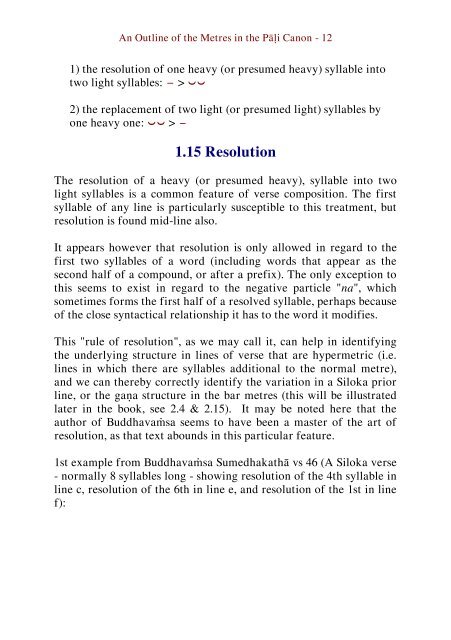An Outline of the Metres in the Pāḷi Canon
A concise but thorough explanation of the metres that are found in the Pāli canon, along with examples and glossary.
A concise but thorough explanation of the metres that are found in the Pāli canon, along with examples and glossary.
Create successful ePaper yourself
Turn your PDF publications into a flip-book with our unique Google optimized e-Paper software.
<strong>An</strong> <strong>Outl<strong>in</strong>e</strong> <strong>of</strong> <strong>the</strong> <strong>Metres</strong> <strong>in</strong> <strong>the</strong> <strong>Pāḷi</strong> <strong>Canon</strong> - 12<br />
1) <strong>the</strong> resolution <strong>of</strong> one heavy (or presumed heavy) syllable <strong>in</strong>to<br />
two light syllables: − > ⏑⏑<br />
2) <strong>the</strong> replacement <strong>of</strong> two light (or presumed light) syllables by<br />
one heavy one: ⏑⏑ > −<br />
1.15 Resolution<br />
The resolution <strong>of</strong> a heavy (or presumed heavy), syllable <strong>in</strong>to two<br />
light syllables is a common feature <strong>of</strong> verse composition. The first<br />
syllable <strong>of</strong> any l<strong>in</strong>e is particularly susceptible to this treatment, but<br />
resolution is found mid-l<strong>in</strong>e also.<br />
It appears however that resolution is only allowed <strong>in</strong> regard to <strong>the</strong><br />
first two syllables <strong>of</strong> a word (<strong>in</strong>clud<strong>in</strong>g words that appear as <strong>the</strong><br />
second half <strong>of</strong> a compound, or after a prefix). The only exception to<br />
this seems to exist <strong>in</strong> regard to <strong>the</strong> negative particle "na", which<br />
sometimes forms <strong>the</strong> first half <strong>of</strong> a resolved syllable, perhaps because<br />
<strong>of</strong> <strong>the</strong> close syntactical relationship it has to <strong>the</strong> word it modifies.<br />
This "rule <strong>of</strong> resolution", as we may call it, can help <strong>in</strong> identify<strong>in</strong>g<br />
<strong>the</strong> underly<strong>in</strong>g structure <strong>in</strong> l<strong>in</strong>es <strong>of</strong> verse that are hypermetric (i.e.<br />
l<strong>in</strong>es <strong>in</strong> which <strong>the</strong>re are syllables additional to <strong>the</strong> normal metre),<br />
and we can <strong>the</strong>reby correctly identify <strong>the</strong> variation <strong>in</strong> a Siloka prior<br />
l<strong>in</strong>e, or <strong>the</strong> gaṇa structure <strong>in</strong> <strong>the</strong> bar metres (this will be illustrated<br />
later <strong>in</strong> <strong>the</strong> book, see 2.4 & 2.15). It may be noted here that <strong>the</strong><br />
author <strong>of</strong> Buddhavaṁsa seems to have been a master <strong>of</strong> <strong>the</strong> art <strong>of</strong><br />
resolution, as that text abounds <strong>in</strong> this particular feature.<br />
1st example from Buddhavaṁsa Sumedhakathā vs 46 (A Siloka verse<br />
- normally 8 syllables long - show<strong>in</strong>g resolution <strong>of</strong> <strong>the</strong> 4th syllable <strong>in</strong><br />
l<strong>in</strong>e c, resolution <strong>of</strong> <strong>the</strong> 6th <strong>in</strong> l<strong>in</strong>e e, and resolution <strong>of</strong> <strong>the</strong> 1st <strong>in</strong> l<strong>in</strong>e<br />
f):

















